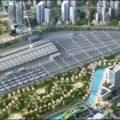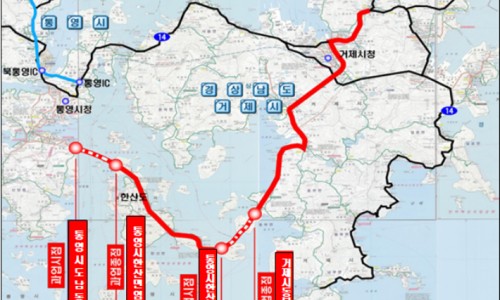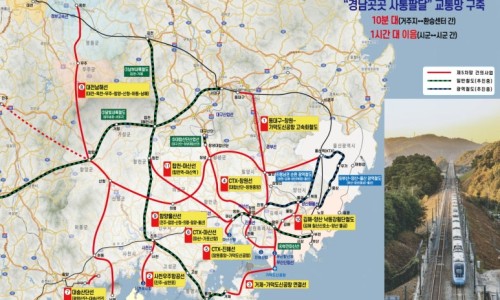Table of Contents
Finally Yielding After 20 Years of Long-standing Desire for the Geoje-Tongyeong Expressway
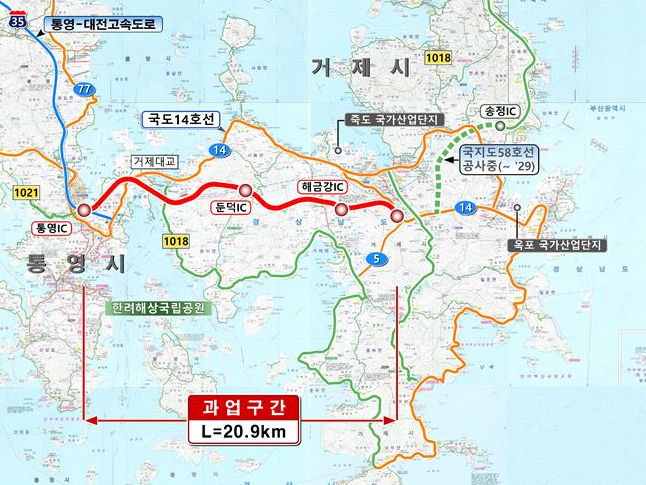
The construction project for the highway connecting Geoje and Tongyeong in Gyeongnam has passed the deliberation of the 8th Financial Project Evaluation Committee of the Ministry of Strategy and Finance. This passing of the preliminary feasibility study is a result achieved 20 years after the first survey in 2002, paving the way for the long-standing desire of local residents to be actively pursued.
This expressway is designed to connect Tongyeong IC in Yongnam-myeon, Tongyeong City, to Geoje IC in Sangmun-dong, Geoje City, and spans a total length of 20.9 km with four lanes. Additionally, new ICs including Dundeok IC, Haeguemgang IC, and Geoje IC will be constructed. A total budget of 1.5 trillion won is planned for this project, with a completion target set for 2035.
Gyeongnam Tongyeong Geoje Development Project
Map and Overview of the Geoje-Tongyeong Expressway
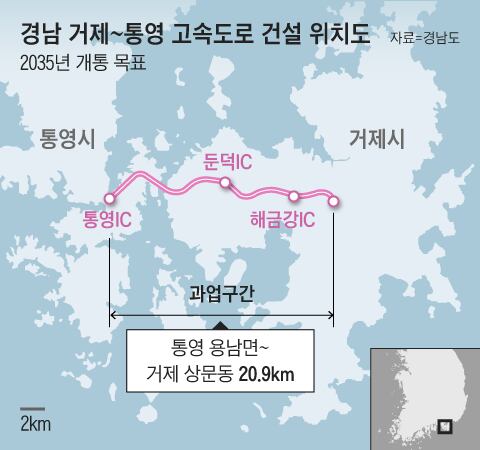
The highway connecting Geoje and Tongyeong comprises several key elements. This road will have three interchanges (Dundeok IC, Haeguemgang IC, and Geoje IC), 16 bridges (with a total length of 4.5 km), and 6 tunnels (with a total length of 6.6 km). This route is expected to resolve the frequently occurring congestion issues of National Route 14 and significantly enhance the logistical efficiency of the shipbuilding and marine industry.
Moreover, this expressway will not merely connect Geoje and Tongyeong but will also link to the Southern Inland Railway, Gadukdo New Airport, and the maritime national road (National Route 5) connecting the islands of the southern coast, making it a crucial axis for the industrial and tourism development of the southern coastal region. This expansion of the transportation network is expected to have a positive impact on the local economy.
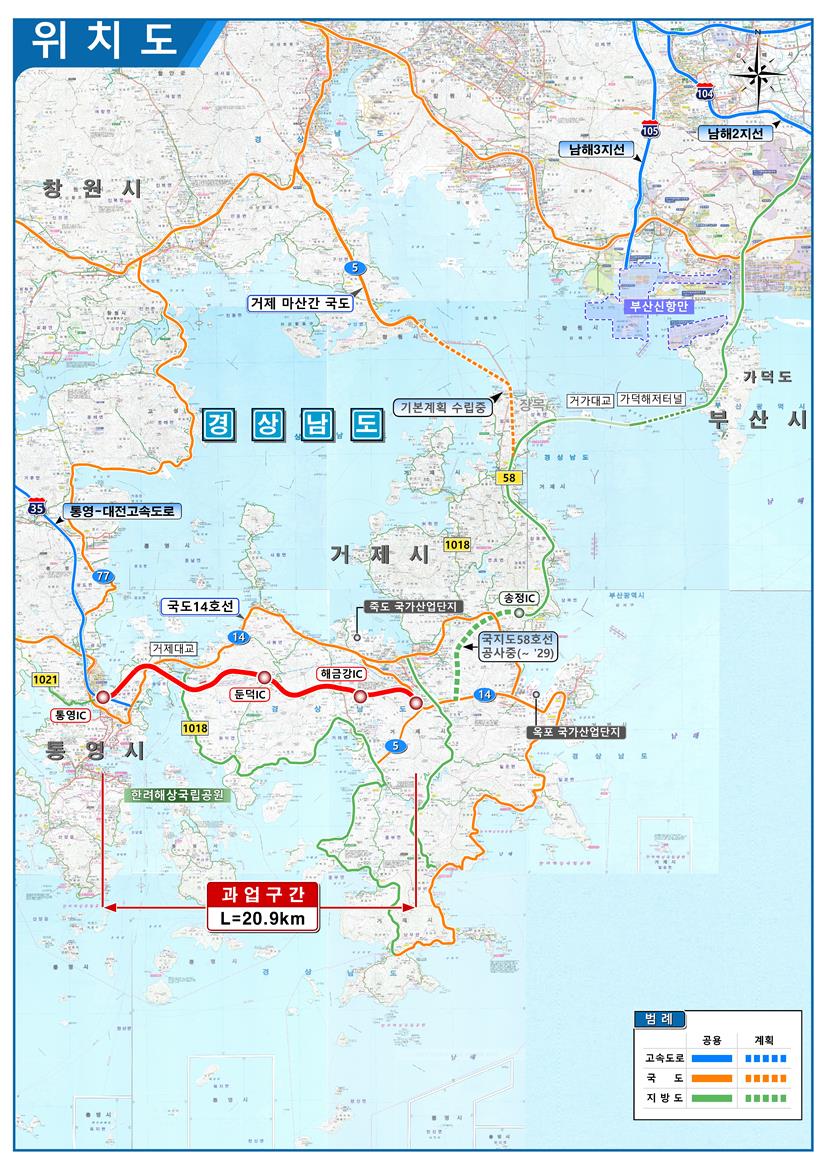
Resuming After 20 Years of Stagnation
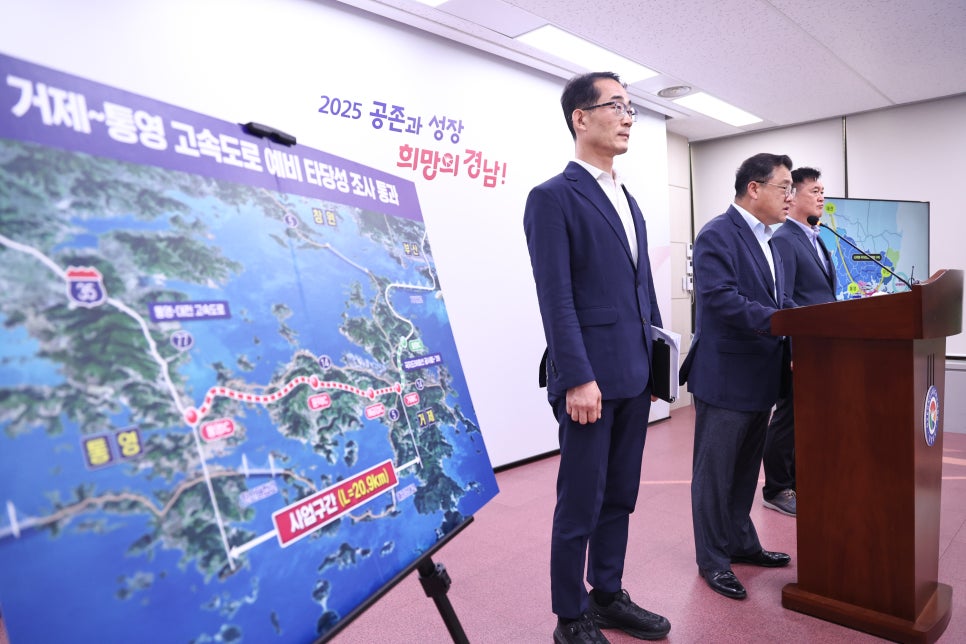
This project passed the preliminary feasibility study in 2002 and completed the basic design in 2007, but was halted due to the audit office pointing out a lack of economic viability. After a long period of stagnation, the persistent efforts of Gyeongsangnam-do and the local community culminated in its resumption.
Gyeongsangnam-do held several discussions with the central government for this achievement, strengthening public-private cooperation through policy workshops, citizen resolution rallies, and petition campaigns. Thanks to these multifaceted efforts, the long-standing desire of local residents has been realized after 20 years.
Expected Effects: Transportation, Economy, and Tourism

When the expressway opens, the travel time between Geoje and Tongyeong is expected to be reduced by about 20 minutes during peak hours. Additionally, it is projected to save costs amounting to a total of 40 billion won annually through reduced travel time, decrease in air pollution by 6 billion won, and a reduction in traffic accidents leading to an estimated savings of 20 billion won, resulting in a total cost-saving effect of approximately 40 billion won.
This economic effect is significant, with a production inducement effect estimated at about 2.9 trillion won and a value-added inducement effect of approximately 1.23 trillion won. Furthermore, around 23,500 jobs are expected to be created as a result. These changes are anticipated to have a positive impact on the local economy.
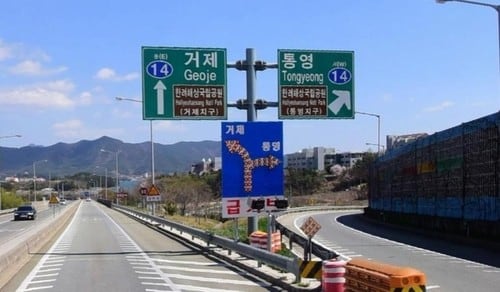
The opening of Gadukdo New Airport is anticipated to greatly improve access to Hallyeohaesang National Park and tourist destinations along the southern coast, which is expected to positively impact tourism revitalization. Consequently, the southern coast will establish itself as a center for marine tourism in Northeast Asia.
Future Promotion Plans
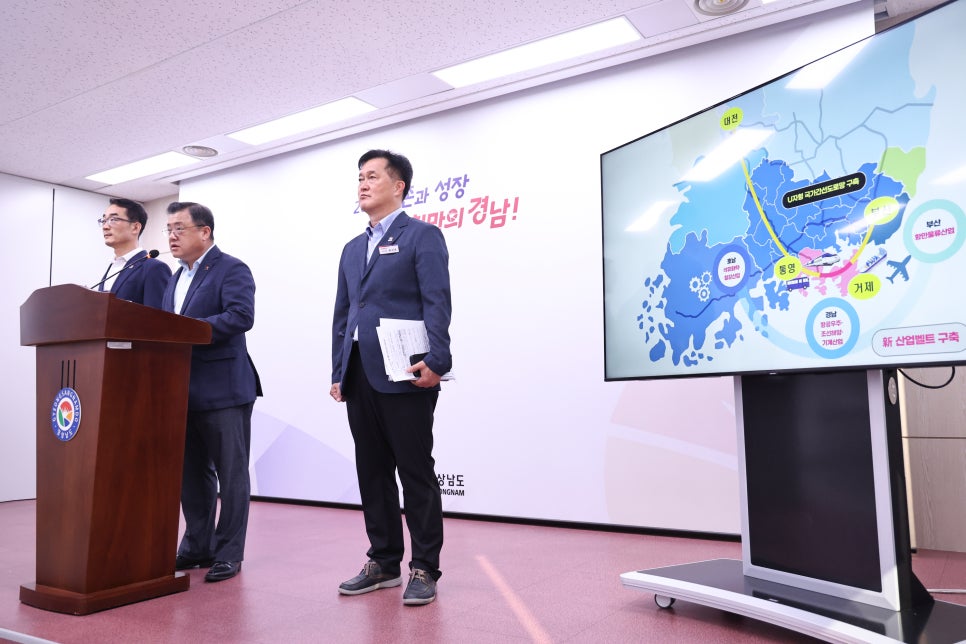
Gyeongnam Province plans to closely collaborate with the central government to swiftly proceed with the subsequent administrative procedures, including feasibility evaluations, basic and detailed designs.
Additionally, they will establish an integrated transportation strategy for the southern coastal region, which includes adjacent areas such as Goseong, Sacheon, and Changwon, promoting strategic linkages to create synergies between industries and develop the marine tourism belt.
The highway connecting Geoje and Tongyeong is expected to go beyond being just a transportation infrastructure project; it aims to promote logistical innovation in the shipbuilding industry, enhance the competitiveness of southern coastal tourism, and serve as a driving force for local economic growth.
#GeojeTongyeongExpressway, #FeasibilityStudyPassed, #RouteMap, #TongyeongYongnamMyeon, #GeojeSangmundong, #SouthernInlandRailway, #GadukdoNewAirport, #GyeongnamLongCherishedProject, #ShipbuildingMarineIndustry, #LogisticsInnovation, #BusanGyeongnamTransportNetwork, #SouthernCoastTourism, #GyeongnamEconomy, #SouthernCoastDevelopment, #HighwayOpening, #TransportationNetworkExpansion, #GyeongnamNews, #GeojeTransport, #TongyeongTransport, #SouthernCoastKeyAxis, #RegionalBalancedDevelopment, #NationalRoute14Substitution, #IndustrialSynergy, #MarineTourismBelt, #SouthernCoastMegaTransportNetwork, #GyeongnamPolicy, #BusanGyeongnamCoexistence, #CompletionBy2035, #LocalEconomicRevitalization, #SouthernCoastExpressway
Frequently Asked Questions (FAQ)
Q. What process has the Geoje-Tongyeong Expressway project undergone?
The Geoje-Tongyeong Expressway project resumed after 20 years since the preliminary feasibility study began in 2002 and recently passed the feasibility study evaluation.
This highway project passed the preliminary feasibility study in 2002 and completed the basic design in 2007, but was halted due to the audit office citing a lack of economic viability. After about 20 years of stagnation, the project's resumption was made possible through persistent public-private collaboration efforts from Gyeongsangnam-do and the local community alongside multifaceted discussions with the central government. Recently, it cleared the Ministry of Strategy and Finance's 8th Financial Project Evaluation Committee, paving the way for active promotion.
Q. How is the major route and facilities of the Geoje-Tongyeong Expressway structured?
It is composed of a total of 20.9 km of four-lane expressway with three interchanges: Dundeok IC, Haeguemgang IC, and Geoje IC, as well as 16 bridges and 6 tunnels.
This expressway connects Tongyeong IC in Yongnam-myeon, Tongyeong City, to Geoje IC in Sangmun-dong, Geoje City, spanning a total length of 20.9 km. Three new interchanges (Dundeok IC, Haeguemgang IC, and Geoje IC) will be constructed, alongside 16 bridges (totaling 4.5 km) and 6 tunnels (totaling 6.6 km). This route aims to alleviate significant congestion on the existing National Route 14 and improve the logistical efficiency of the shipbuilding and marine industry.
Q. What are the expected effects of this expressway on the local economy and traffic?
A 20-minute reduction in travel time is expected along with an annual cost savings of approximately 40 billion won, with a production inducement effect of 2.9 trillion won and the creation of about 23,500 jobs.
When the expressway opens, the travel time between Geoje and Tongyeong is expected to be reduced by about 20 minutes, including savings in travel time, reduced air pollution, and decreased traffic accidents leading to an estimated total of approximately 40 billion won in annual cost-saving effects. Additionally, a production inducement effect of about 2.9 trillion won, value-added effects of 1.23 trillion won, and job creation of 23,500 individuals are anticipated, contributing significantly to revitalizing the local economy.
Q. How will the Geoje-Tongyeong Expressway connect with other transportation networks?
It will connect with major transportation networks such as the Southern Inland Railway, Gadukdo New Airport, Hallyeohaesang National Park, and National Route 5.
This expressway is linked to the Southern Inland Railway, Gadukdo New Airport, and the maritime national road (National Route 5) that connects the islands of the southern coast, serving as a central axis for the region’s industrial and tourism development. Furthermore, with the opening of Gadukdo New Airport, access to Hallyeohaesang National Park and tourist destinations on the southern coast will improve, positively impacting tourism revitalization and regional development.
Q. What are the future plans and strategies for the Geoje-Tongyeong Expressway?
Plans are underway to quickly advance feasibility assessments and designs in cooperation with the central government, as well as establishing an integrated transportation strategy for the southern coastal region and developing a marine tourism belt.
Gyeongnam Province plans to smoothly carry out subsequent administrative procedures, including feasibility evaluations and basic as well as detailed designs in close cooperation with the central government. Furthermore, they are working on an integrated transportation strategy for the southern coastal area in connection with neighboring regions to create synergies between industries and establish a marine tourism belt. This is to ensure that the expressway not only serves as transportation infrastructure but also leads to innovation in logistics for the shipbuilding industry, enhances the tourism competitiveness of the southern coast, and acts as a key driver for local economic growth.
